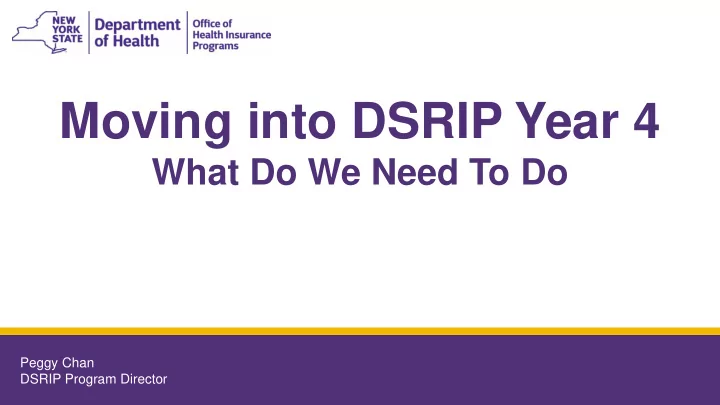

Moving into DSRIP Year 4 What Do We Need To Do Peggy Chan DSRIP Program Director
2 DSRIP Implementation Timeline and Key Benchmarks Focus on Infrastructure Focus on Continued Focus on Project Development/System System/Clinical Outcomes/Sustainability Design Improvement We are here Q1|Q2|Q3|Q4 Q1|Q2|Q3|Q4 Q1|Q2|Q3|Q4 Q1|Q2|Q3|Q4 Q1|Q2|Q3|Q4 DY0 DY1 DY2 DY3 DY4 DY5 • PPS Project Plan Valuation Submission/Approval Domain 3: Clinical Domain 2: System Domains 2 & 3 are • PPS first DSRIP Payment of Project Plan Transformation P4P completely P4P Improvement P4P • PPS Submission of Performance Measures Performance Measures Implementation Plan and First begin begin Quarterly Report Domain 4: PPS working in collaboration with community and diverse set of service providers to address statewide public health priorities; system improvements and increased quality of care will positively impact health outcomes of total population.
3 What We Need to Do in DY 4
4 Performance !
5 Statewide Accountability Milestones The STCs identify four measures for which statewide performance is evaluated, beginning in DY3: Statewide Milestone Pass Criteria More metrics are improving on a statewide level than are worsening 1 1. Statewide metrics performance 2. Success of projects statewide 2 More metrics achieving an award than not 1) The growth in the total Medicaid spending is at or below the target trend rate (DY4-5 only) and 3. Total Medicaid spending 3 2) The growth in statewide total IP & ED spending is at or below the target trend rate (DY3-5) 4. Managed care plan Achieving VBP roadmap goals related to value-based payment transition If the state fails any of the four statewide milestones: DY 3 DY 4 DY 5 Penalty $74.09M (5% of funds) $131.71M (10% of funds) $175.62M (20% of funds) Notes: 1. Based on previous year and baseline comparisons 2. Based on project-specific and population-wide quality metrics 3. At or below target based on trend rate
6 Statewide Milestone #1 Summary MY2 Statewide Milestone #1 is a test of the universal set of statewide delivery system improvement measures* which consist of 18 measures. # Statewide Category Statewide Measure Name Maintain/Improve Maintain/Improve MY0 vs MY2 MY1 vs MY2 1 Potentially Avoidable Services Potentially Preventable Readmissions (rate per 100,000) Maintain/Improve Maintain/Improve 2 Potentially Avoidable Services Potentially Preventable Emergency Room Visits (rate per 100) Maintain/Improve Maintain/Improve 3 Potentially Avoidable Services PDI - 90 - Composite of All Pediatric Measures Maintain/Improve Maintain/Improve 4 Potentially Avoidable Services PQI - 90 - Composite of All Measures Maintain/Improve Maintain/Improve 5 Access to Care Children's Access to Primary Care - 12 to 24 Months Worsen Maintain/Improve 6 Access to Care Children's Access to Primary Care - 25 months to 6 years Maintain/Improve Maintain/Improve 7 Access to Care Children's Access to Primary Care - 7 to 11 years Worsen Worsen 8 Access to Care Children's Access to Primary Care - 12 to 19 years Worsen Worsen 9 Access to Care Adult Access to Preventive or Ambulatory Care – 20 to 44 years Worsen Maintain/Improve 10 Access to Care Adult Access to Preventive or Ambulatory Care – 45 to 64 years Worsen Maintain/Improve 11 Access to Care Adult Access to Preventive or Ambulatory Care – 65 and older Worsen Worsen 12 Primary Care Percent of PCP (Primary Care Providers) Meeting PCMH or Advance Primary Care Standards Maintain/Improve Worsen 13 Primary Care Primary Care - Usual Source of Care (C&G CAHPS) N/A Maintain/Improve 14 Primary Care Primary Care - Length of Relationship (C&G CAHPS) N/A Worsen 15 Timely Access Getting Timely Appointments, Care and Information (C&G CAHPS) N/A Worsen 16 Care Transitions Care Coordination (C&G CAHPS) N/A Worsen 17 System Integration Meaningful Use Providers Percent of Eligible Providers Who Have Participating Agreements with Qualified Entities N/A N/A 18 System Integration Meaningful Use Providers Percent of Eligible Providers Who Are Able to Participate in Bidirectional Exchange N/A N/A * The Independent Assessor will determine if the state has passed this milestone beginning in DY3. This milestone will be considered passed in any given year if more metrics in these domains are improving on a statewide level than are worsening, as compared to the prior year as well as compared to initial baseline performance. ^ The denominator for this measure is less than 30 for some Performing Provider System's, therefore the rates may not be stable due to small numbers. N/A: Data collection began in MY1 and/or MY2. Therefore, comparative results not available.
7 Value Based Payment
8
9
10 Sustainability
11 Start With Why
12 ‘The Golden Circle’ What What: Provide more cost How effective and integrated healthcare while also addressing social determinants of health Why How: DSRIP Why: To improve the health and well being of 6.6 million New Yorkers
13
Performing Provider Systems (PPS) Responsibilities must include: PPSs should include: • Hospitals Community health care needs assessment • Health Homes based on multi-stakeholder input and objective data. • Skilled Nursing Facilities • Clinics & FQHCs Building and implementing a DSRIP • Behavioral Health Providers Project Plan based upon the needs assessment in alignment with DSRIP • Home Care Agencies strategies. • Primary Care Providers • Other key stakeholders Meeting and reporting on DSRIP Project Plan process and outcome milestones.
15
16 MAX Series Multidisciplinary Action Teams - New Partnerships - Empowered to make a change! - Impact! - Culture Change! - Making a difference in patients’ lives
17 MAX Series Multidisciplinary Action Teams - New Partnerships - Empowered to make a change! - Impact! - Culture Change! - Making a difference in patients’ lives
18
19
20
21
22 Key Questions You Should Consider as You Move into DSRIP Year 4
23 1. What is your PPS’ current why? 2. Do your network partners understand and are they inspired by your why? 3. What is your long term future why? As a community As a PPS 4. Are you starting a movement?
24 Start A Movement!
Recommend
More recommend